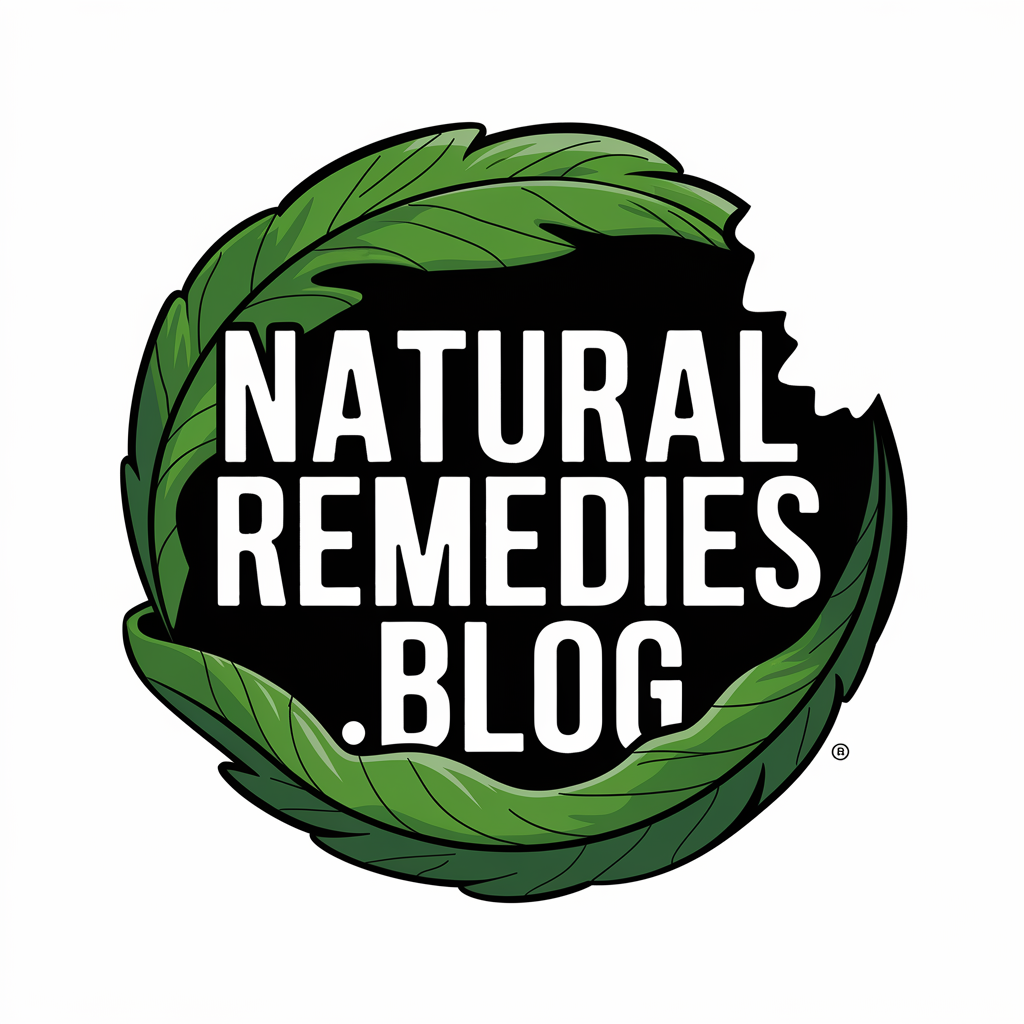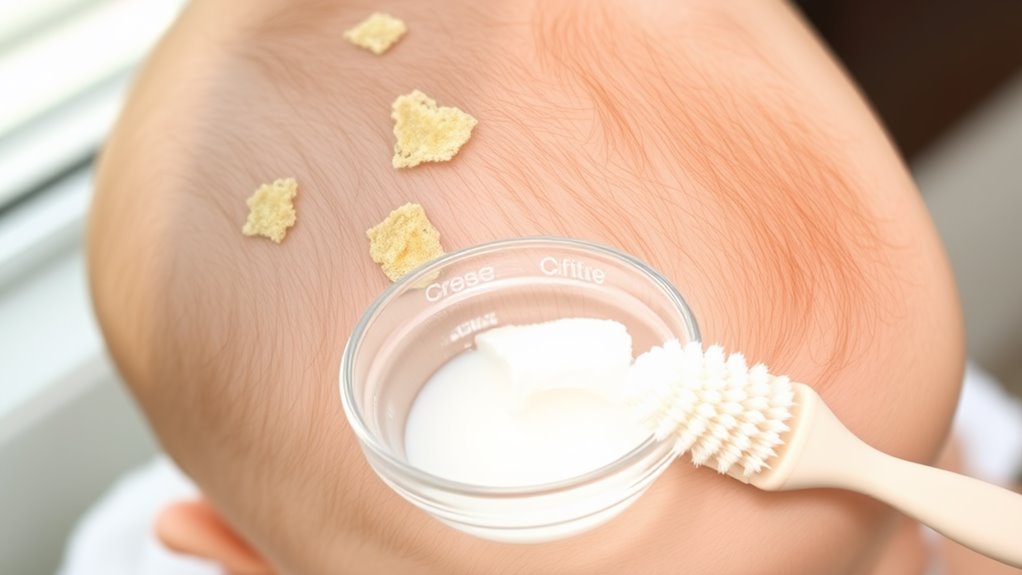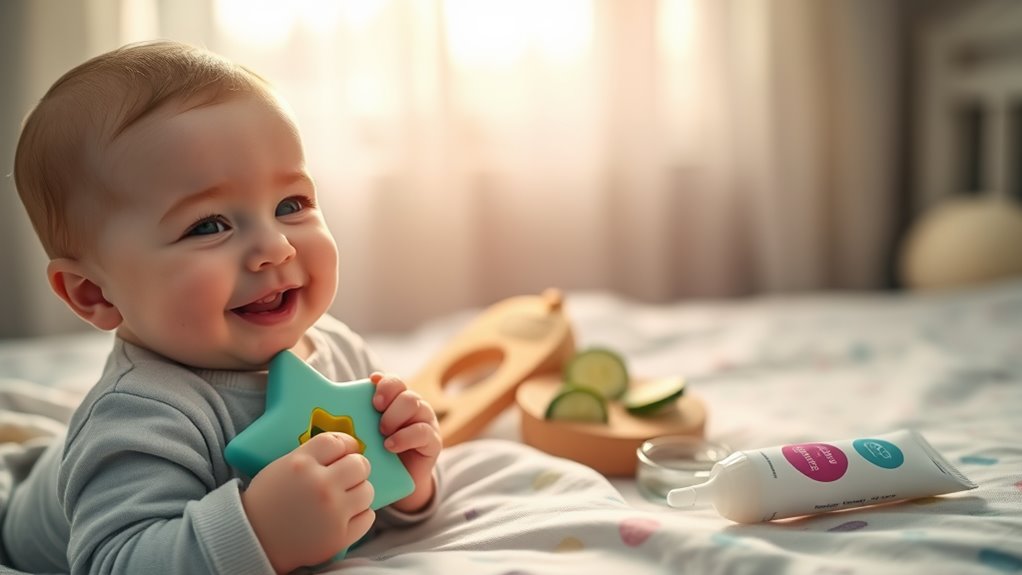Cradle Cap Cure I Wish I Knew About Sooner
You’ll find quick relief from cradle cap using this dermatologist-approved method: Apply mineral oil (not olive oil) to your baby’s scalp and let it soak for 15 minutes. Gently brush the softened scales in circular motions with a soft-bristled brush, then wash with mild baby shampoo. Repeat this process 2-3 times weekly while maintaining daily cleansing with gentle products. This precise technique offers more effective results than traditional approaches to treating those stubborn yellow scales.
Key Takeaways
-
Avoid olive oil treatments as they feed Malassezia yeast; use mineral oil instead for better results in treating cradle cap.
-
Soak scalp with mineral oil for 15 minutes before gentle brushing, rather than immediate scraping or harsh combing.
-
Use a soft-bristled brush in circular motions for 5-10 minutes to safely lift scales without damaging delicate skin.
-
Implement daily washing with mild baby shampoo combined with twice-weekly anti-dandruff treatments for consistent improvement.
-
Apply petroleum jelly before shampooing to loosen stubborn scales, but never leave it on the scalp overnight.
Understanding Cradle Cap: More Than Just Flakes
What exactly causes those persistent flaky patches on your baby’s scalp?
While you’re searching for cradle cap remedies, it’s crucial to understand that this common condition isn’t your fault or related to hygiene practices.
The yellowy-white, scaly patches typically appear between two weeks and 12 months of age, with most cases peaking around 3-6 weeks. An overproduction of excess sebum is often involved in the development of this skin condition.
The science points to two main culprits: maternal hormones that overstimulate your infant’s oil glands after birth, and Malassezia yeast that thrives in the excess sebum.
You’ll notice greasy or scaly patches primarily on the scalp, though they can spread to the face, ears, or diaper area.
Don’t worry – it’s non-contagious, painless, and doesn’t cause itching or hair loss.
The condition is self-limiting and usually resolves spontaneously.
Regular daily shampooing with a gentle baby shampoo can help prevent the condition from developing.
My Early Struggles With Baby’s Scalp Care
Three common pitfalls marked my initial attempts at managing my baby’s cradle cap.
I’d mistakenly used olive oil, which actually worsened the condition by feeding the Malassezia yeast.
You’ll want to avoid this common error and opt for mineral oil instead.
I also relied on adult dandruff shampoos that irritated my baby’s delicate scalp, not realizing that gentler alternatives existed.
Like many parents, I’d scratch at the stubborn scales with my fingernails and plastic combs, risking infection and skin damage.
I’ve since learned that proper technique involves a 15-minute mineral oil soak followed by gentle brushing with soft bristles.
Daily washing with baby shampoo, plus twice-weekly anti-dandruff treatments for persistent cases, proves far more effective than my initial haphazard approach.
A healthcare professional’s assessment confirmed the diagnosis during a simple visual examination of my baby’s scalp.
The Game-Changing Natural Treatment Method
When it comes to treating cradle cap naturally, a systematic approach combining gentle oils and proper technique yields remarkable results. You’ll want to focus on a three-step process: softening, lifting, and removing the scales. While these steps are effective, remember that cradle cap is not caused by poor hygiene and may require consistent treatment. Additionally, using coconut oil can help nourish the scalp and promote a healthier environment as you perform this routine.
| Step | Action | Duration | Tools Needed | Key Tips |
|---|---|---|---|---|
| 1. Soften | Apply emollient | 2-3 hours | Coconut/olive oil | Massage gently |
| 2. Lift | Brush scales | 5-10 minutes | Soft brush | Use circular motions |
| 3. Remove | Shampoo | 2-3 minutes | Mild baby shampoo | Rinse thoroughly |
| 4. Prevent | Daily care | Ongoing | Natural oils | Don’t overwash |
| 5. Monitor | Check scalp | Weekly | None | Watch for changes |
For optimal results, you’ll need to perform this routine 2-3 times weekly. Remember to use baby-friendly products and maintain consistent gentle care between treatments.
Essential Tips for Daily Scalp Maintenance
Maintaining your baby’s scalp health requires a consistent daily routine built around gentle cleansing techniques and appropriate products. You’ll need to wash your baby’s hair once daily using a mild, unscented baby shampoo while gently massaging the scalp with your fingertips or a soft-bristled brush. Additionally, it’s important to be aware of how teething symptoms can affect your baby’s comfort and sleep patterns during this process.
During bathtime, use a baby washcloth for careful cleansing, and avoid scratching or harsh rubbing. If you’re dealing with stubborn scales, apply petroleum jelly or mineral oil before shampooing to help loosen them, but don’t leave these products on the scalp. Remember that this common condition is not contagious and poses no risk to other children.
After washing, use a fine-toothed comb or soft brush to prevent scale buildup. While specialty cradle cap products are available, stick to pediatrician-approved options and always rinse thoroughly to maintain optimal scalp health.
When Home Remedies Need Medical Backup
While most cases of cradle cap respond well to daily home care, some situations require professional medical attention.
You’ll need to contact your doctor if you notice persistent symptoms despite consistent home treatment, or if your baby’s scalp shows signs of infection like swelling, redness, or foul odors. Yeast infections can also contribute to these symptoms, so it’s essential to monitor unusual discharge closely.
Don’t try over-the-counter medications without consulting your healthcare provider first, as some products can cause allergic reactions or skin irritation in infants.
Affecting 70% of infants, cradle cap is an extremely common condition that often responds to proper medical intervention when needed.
Your doctor may prescribe low-potency hydrocortisone for inflammation or antifungal treatments if a yeast infection is present.
When using prescription treatments, watch carefully for any adverse reactions on your baby’s skin.
Regular monitoring and open communication with your healthcare provider will ensure the condition doesn’t worsen and receives appropriate medical management when needed.
References
- https://www.mayoclinic.org/diseases-conditions/cradle-cap/symptoms-causes/syc-20350396
- https://my.clevelandclinic.org/health/diseases/15786-cradle-cap-seborrheic-dermatitis-in-infants
- https://kidshealth.org/en/parents/cradle-cap.html
- https://www.johnsonsbaby.com/baby-tips/what-is-cradle-cap
- https://www.webmd.com/skin-problems-and-treatments/treating-cradle-cap-in-children
- https://www.seattlechildrens.org/conditions/a-z/cradle-cap/
- https://www.mayoclinic.org/diseases-conditions/cradle-cap/diagnosis-treatment/drc-20350400
- https://www.aad.org/public/everyday-care/hair-scalp-care/scalp/treat-cradle-cap
- https://www.healthline.com/health/parenting/baby-dry-scalp
- https://americanpregnancy.org/healthy-pregnancy/first-year-of-life/cradle-cap-symptoms-and-natural-treatments/







